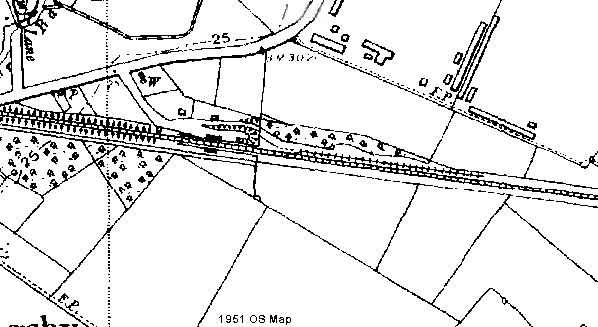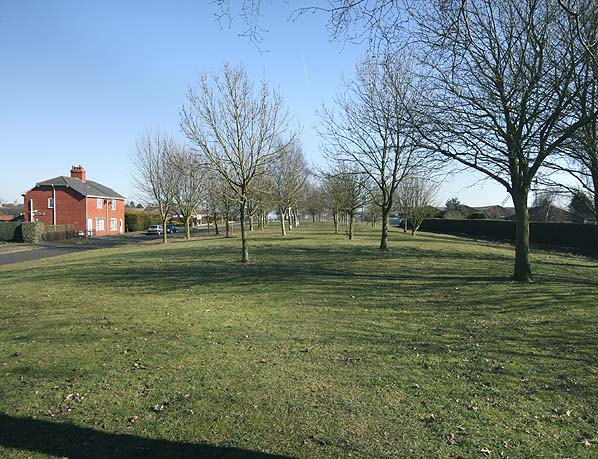Notes: Coningsby station was sited on an embankment and comprised two timber platforms each with a timber waiting room with a canopy. A single-storey red brick booking office stood at the west end of the down platform, it was similar in design to the others on the New Line. A signalbox at the east end of the up platform controlled access to the goods yard which was on the opposite side of the line and comprised a single siding running parallel with the main line..
During World War II Coningsby took deliveries from munitions trains several times a week. These consisted of considerable amounts of bombs and ammunition for the nearby RAF Coningsby.
Coningsby lost its goods facilities on 30th March 1964. The station became unstaffed on 7th October, 1968 and final closure was on 5th October 1970; the station canopies were removed before closure. The station was quickly demolished.
BRIEF HISTORY OF THE KIRKSTEAD & LITTLE STEEPING RAILWAY (NEW LINE)
The East Lincolnshire Railway (ELR) was proposed as one of a group of allied railway bills during 1845 and 1846 as part of plans by the Great Northern Railway (GNR) to provide a link between London and Leeds/York. The section between Louth and Grimsby was opened on 1st March 1848 quickly followed by Louth to Boston on 1st October 1848.
 |
The Wainfleet & Firsby Railway (W & FR) opened a line between Firsby on the ELR and Wainfleet to goods traffic on 11th September 1871 and to passengers on 24th October 1871. At this time Skegness was primarily a fishing village with a small harbour; the development of Skegness as a holiday resort began with the coming of the railway. With the |
opening of the ELR buses carried passengers from Burgh on Bain station into Skegness. Keen to take advantage of the potential tourist traffic, the W & FR obtained an Act to extend their line into the rapidly expanding Skegness and their extension opened on 28th July 1873. The majority of holiday traffic to the new holiday resort came from the south, much of it from London. To attract visitors from the north of England a number of schemes were proposed to build a direct link between Lincoln and Skegness replacing the circuitous routes that already existed.
There was also a demand for cross-country freight traffic with other companies keen to bring their goods into what the GNR regarded as a poor area reliant on a good harvest to ensure prosperity in any year. In a bad year like 1879 when a wet summer and autumn destroyed much of their harvest people in Lincolnshire could barely afford products like coal. In 1884 the Lincoln & Skegness Railway Bill was approved by the House of Commons despite opposition from the GNR. In the Lords the GNR continued their opposition refusing subscribe to, take over, or work the proposed railway; the Bill was defeated in the Lords.
 |
Within a few years another Bill was put before Parliament and on 16th September 1887 the Lincoln, Horncastle, Spilsby & East Coast Railway (HS&ECR) received authority to build a line from Stixwould on the Lincolnshire Loop Line Lincolnshire Loop Line which had been opened by the GNR between Boston and Lincoln in 1848 as part of their main line from London to the north. The HS&ECR would have running powers to Lincoln and Firsby including junctions with the Horncastle, Spilsby and Skegness lines. On this occasion the GNR didn't appose the Bill agreeing to work the line for 60 per cent of the receipts. The company was unable to raise sufficient capital and the GNR declined an offer to take over the powers when the scheme was abandoned in 1891.
There were no further proposals for a northern route into Skegness until 1910 when Skegness Town Council approached the GNR asking for better service to the resort from Manchester, Birmingham and Leeds. It suggested a line linking the Spilsby & Horncastle branches stating that if the GNR was not sympathetic they would seek help from the Midland Railway. An alternative scheme was also suggested with a new line being built from Kirkstead on the Boston - Lincoln line to Little Steeping on the ELR. There were already summer excursions from Manchester with through carriages for Skegness being detached from a Yarmouth train.
| The GNR Board approved the latter scheme as a light railway to keep land acquisition prices low. Plans were sent to the Light Railway Commission on 18th May, 1911 and after holding an enquiry at Boston on 18th July they granted the order with three years given as the limit for the compulsory purchase of any land required. Although the new railway’s official title was |
 |
‘The Kirkstead and Little Steeping Railway’ it was universally known as the ‘New Line’.
The New Line was engineered by Alexander Ross and construction of the 15-mile double track line started at both ends in March 1912. The line left the loop line at Coningsby junction 1 1/2 miles south of Kirkstead station (renamed Woodhall Junction 10th July 1922), joining the ELR at Bellwater Junction, between Eastville and Little Steeping. The land was generally flat so there were no engineering difficulties with only three roads requiring bridges.
Intermediate stations were built at Coningsby, Tumby Woodside, New Bolingbroke, Stickney and Midville; all the stations being provided with goods facilities and substantial station houses and large brick booking offices. The new line opened for goods on 1st June and passengers on 1st July, 1913 with four local trains running each way between Lincoln and Skegness in addition to the express service between Sheffield and Skegness. In the beginning a 25 mph speed restriction was imposed by the Board of Trade, but this was later increased to 50 mph for much of its length.
In 1916 the GNR Board decided to lift one ‘New Line’ track to assist the war effort. The track was to be relayed in France but unfortunately the vessel carrying the rails sank in the English Channel. Although holiday traffic was greatly reduced and tourist tickets withdrawn, the daily Lincoln-Skegness service continued throughout the war. The missing track was reinstated and in use again from 10th July, 1923.
The section of the Lincolnshire loop line between Woodhall Junction and Boston was closed to passengers and goods on 17th June, 1963 shortly before the Beeching closures leaving a service from Lincoln over the loop line to Woodhall Junction and then via the 'new line' to Firsby. Little Steeping station between Bellwater Junction and Firsby had already closed on 11th September 1961. British Railways also suggested the closure of the Lincoln to Skegness line to take effect from 6th June, 1964. This would have seen the closure of the New Line as well as the remainder of the Lincoln to Boston line. With the Grimsby to Boston line also under threat the biggest local enquiry held by the Transport Users’ Consultative Committee took place in Skegness on 15th and 16th September, 1964 to hear objections to the proposals.
 |
A strong case was put forward to stop the closures which would leave the greater part of Lincolnshire with no rail service. British Railways were accused of deliberately running down the services on lines it wished to close in order to strengthen their case for closure. The findings of the meeting were submitted to the Minister of Transport who concluded that the |
British Railways board should re-examine its proposals. This it did and in due course once again proposed closure, this time with the exception of the Skegness line. A second TUCC inquiry was held at Skegness in May 1968, lasting for two days. The findings were again submitted to the Transport Minister who this time supported the Board’s proposals. He felt that costs of retaining the existing rail services in Lincolnshire could not be justified because of the low usage and the considerable route mileage involved.
On the New Line only Coningsby had regular passengers travelling mainly to Lincoln with very few people using the other intermediate stations. The Minister accepted that passengers travelling on the Coningsby-Lincoln section of the line would suffer inconvenience amounting almost to hardship if this section were closed but he also noted that the numbers concerned were small and he didn't consider that he would be justified in asking the Board to retain this particular service.
Closure of the new line was announced for 5th October 1970 with the last train running on Saturday 3rd October 1970. Today much of the route which crossed flat arable land has gone without trace except for the stations. Only Stickney which was in a cutting and Coningsby which was on a low embankment have disappeared completely.
Direction designations (down and up) are confusing on the New Line, a train travelling from Firsby to Lincoln is initially an 'up' train. (from Firsby it is heading towards London) once it joins the Lincolnshire Loop line at Conningsby Junction it becomes a 'down' train.
Tickets from Michael Stewart, route map drawn by Alan Young
Source: Railways to Skegness by AJ Ludlam. Published 19(7 by Oakwood Press ISBN 0 85361 518 7
Other web sites:Lincolnshire & East Yorkshire Transport Review includes pictures of the line. Lincolnshire Railway's from the past Adam Cartwright's excellent web site crammed with pictures of Lincolnshire stations including the 'New Line'
To see other stations on the 'New Line' click on the station name:
Woodhall Junction, Tumby Woodside, New Bolingbroke, Stickney, Midville & Little Steepng (ELR) |

old4.jpg)


old3.jpg)





old1.jpg)

old_thumb2.jpg)
old_thumb4.jpg)



 Home Page
Home Page